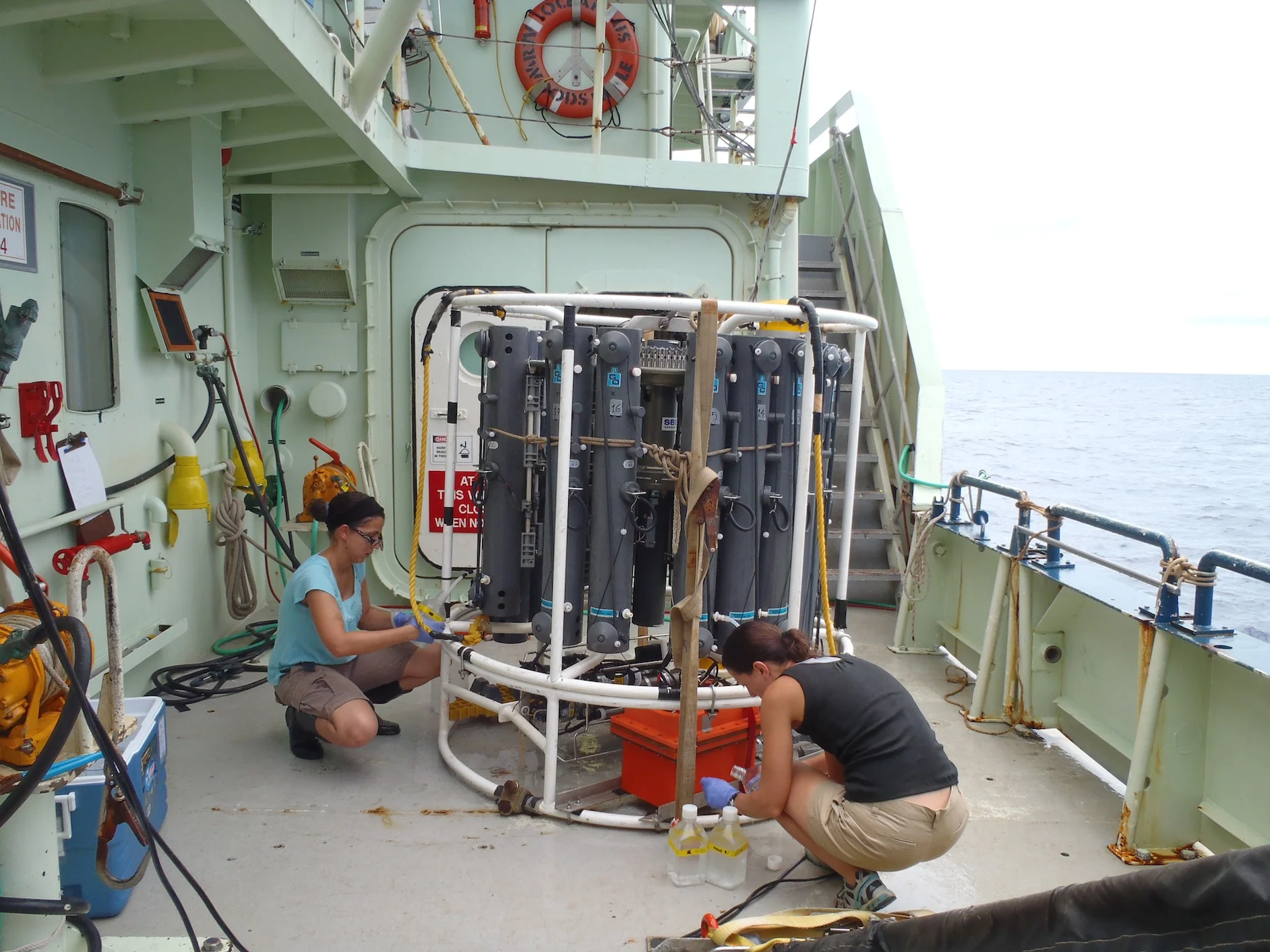A few days ago, I posted on hydrate-derived brine and noted a difference between hydrate-derived brine and salt-dissolution derived brine. Currently, we are studying one of the most spectacular salt-dissolution derived brine ecosystems in the Gulf: The Orca Basin. I could spend a year sampling in Orca and find something new every day. We’re here for one more dive and I cannot wait to get back…hopefully in the next year or two.
Orca Basin is a special place. Salt-dissolution brines come in two flavors, those where brine travels through the sediments upward from deep below the subsurface and is expelled at the seafloor, creating brine pools, mud volcanoes and brine flows. Orca represents the other flavor – where exposed salt comes into contact with seawater, dissolving it, creating a dense brine that seeps into depressions, in some cases filling deep basins.
In the case of Orca, brine fills the bottom of a deep basin leading to a 200m-thick layer of brine below the sea-surface (image-1, courtesy of Pilcher and Blumstein 2007). Don’t get bored for the next couple of minutes, the geology of Orca Basin is fascinating: Orca is termed a deep intraslope basin. It is located in the northern Gulf of Mexico, 345 km SW of New Orleans on the outer continental slope. The basin straddles the Green Canyon and Walker Ridge lease blocks at depths between 1650 and 2470 m.
Orca Basin contains numerous sub-basins, salt ridges, salt canopies, breaching salt diapirs, brine lakes at the seafloor that are 200m thick, brine flows, and anoxic sediments. The anoxic brine basin basin occupies ~400 km2 of seafloor and contains a large, dual-lobed, J-shaped, 220 m deep, anoxic brine lake (~260 parts per thousand salt; for comparison seawater is 35 parts per thousand salt). The basin is separated into two distinct sub-basins (North and South) by a shallow submerged central ridge. The Orca Basin brines are sourced from a sediment breaching salt sill of Jurassic-aged, Louann salt above the eastern basin flank near the center of the basin. So, the salt flows down into the basin from the central sill rather than up through the sediments from below the seawater-brine interface. The donated salts are likely comprised at least partially of gypsum, as evidenced by higher sulfate concentrations in the brine as compared to the overlying seawater.
We’re sampling the “J-shaped” brine basin North to South to chartize the microbial geochemistry of the brine and how it varies; a major goal is to identify areas where salt is entering the basin (image-2). Flowing brine enters the basin from above at a depth of ~2200 m, and mixes with the seawater to produce a sharp gradient in density and chemical distributions. This chemocline is ~50 m thick and over this interval, concentrations of salt, oxygen, methane, nutrients, metals, and dissolved organic carbon change dramatically. The large density differences at the chemocline suppress vertical exchange of solutes between the basin and overlying seawater and acts as a particle trap. The chemocline is a haven for microorganisms, creating a diverse array of niches that support diverse metabolisms.
Biological oxidation of sulfide, ferrous iron, and reduction of manganese oxides, ferric oxides, and sulfate occur along the Orca chemocline fueling dynamic and dense microbial communities. Discrete layers of particulate organic carbon and elevated microbial biomass within the chemocline suggest a diverse suite of heterotrophic and chemosynthetic communities that have yet to be identified. High concentrations of biogenic methane at salinities > 200 PSU (>600 µM) suggest viable microbial activity, specifically methanogenesis at salinities > 260 PSU, which presents a formidable energetic challenge.
These oddities are what makes Orca special and what intrigues the microbiologists and geochemists to sample this basin north to south and top to bottom.
The sediments in Orca show signs of highly reducing conditions; jet black, pyrite and organic-rich sediments, brilliant red, hematite and cinnabar rich sediments, and pink sediments have all been documented at Orca Basin (more on that tomorrow but see the jet black sediments of S Orca in image-6). Levels of iron in the anoxic brine are nearly 1000 times higher than that of the overriding seawater and it contains no detectable sulfide.
So, how do you study these stratified deep brine basins. We use a custom designed sampler to collect brine fuids at fine interals, ~1m (image-3). We profile the water column using the CTD-rosette, which is equipped with 24-10L collection bottles; the CTD allows us to collect fluids over a depth profile, but the best resolution we can get is about 5m (image-4), which is why we need the brine trapper. However, the CTD does provide invaluable information -- it gives us a "snapshot" of the water column structure, so we can tell exactly where the chemocline is in real time (image-5). We sample the bottom basin sediments with the multiple corer and with the Alvin. It’s usually easy to sample bottom sediments with a multiple corer, but not in Orca. The sediment is fluidized mud so catching it a tube is extremely difficult (image-6). We work around the clock on these cruises…24/7 ops and it’s odd but no one really wants to sleep more than 4 or 5 hrs a day (image-7). There are too many exciting things going on and no one wants to miss any of them!
So, CTD-ing is straight forward over-the-work but sampling the find microbial interfaces requires the brine trapper and to do that, you have dive into this briney-deep. The submarine has to be heavy, very heavy, so the descent rate is fast (>40m/min). You can feel the descent - usually the descent rate is 20-25m/min and you can’t feel it. You feel like you’re dropping like a stone, heading towards the bottom. And then you hit the brine (image-1) and you slow down. Quickly. And then you stop. You’re suspended and it’s an odd feeling. When I am on the bottom, I feel secure. I’m on something solid, which gives me comfort. Being suspended in the water column, floating with the current, is a totally different feeling.
The brine has a very heavy particle load (image-9) and using the brine trapper, we can float along at a constant depth and sample the gradients below us at fine (much better than the CTD can do) intervals. It’s surreal to float in the brine watching bright red siponophores, hydrozoans belonging the class Cnidaria, pass by (http://www.theguardian.com/science/gallery/2012/sep/26/siphonophore-longest-animals-on-planet-pictures). And oh, the density of copepods, amphipods and shrimp is just astounding. As we float along, we fill brine trapper bottles with samples (image-10). But the best thing is that, for a microbologist, seeing these layers of microbes face-to-face, so to speak, well, it's just a thril. The nerdy thoughts that go through one's mind -- what are they eating, do they compete, how do they interact -- well, it's fascinatig to see and to think about.
Each bottle has to be purged for 10 minutes and there are 16 bottles, so it takes a while. During the purges, we joke around, watch the Alvin screens (image-11) and enjoying the excitement and continues “wows” coming from Post Doc Sairah Malkin as she experienced her first dive (image-12). The smile on her face says it all.
Tomorrow, I’ll tell you about a special story, two in fact: Finding geological treasure and talking to my daughter and her classmates at Athens Montessori School from the bottom of the ocean. What an experience -- I’ll never forget it and I doubt my daughter and her classmates with either!













